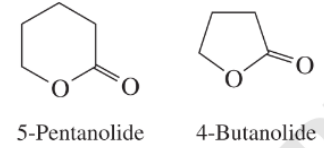
Concept explainers
Suggest a reasonable explanation for each of the following observations:
The second-order rate constant
The second-order rate constant for saponification of ethyl
The second-order rate constant
The second-order rate constant
The second-order rate constant

The second-order rate constant

Interpretation:
The reasonable explanation for given observations is to be stated.
Concept introduction:
The replacement or substitution of one functional group with another different functional group in any chemical reaction is termed as substitution reaction.
In nucleophilic substitution reaction, nucleophile takes the position of leaving group by attacking on the electron deficient carbon atom.
Answer to Problem 45P
Solution:
a) The rate constant for saponification of ethyl trifluoroacetate is more than ethyl acetate because the anionic intermediate is stabilized in ethyl trifluoroacetate.
b) The rate constant for saponification of ethyl acetate is more than ethyl
c) The rate constant for saponification of methyl acetate is more than tert-butyl acetate because the incoming nucleophile is less sterically hindered in methyl acetate.
d) The rate constant for saponification of methyl m-nitrobenzoate is more than methyl benzoate because the anionic intermediate is stabilized in methyl m-nitrobenzoate.
e) The rate constant for saponification of
f) The rate constant for saponification of ethyl
Explanation of Solution
a) The saponification of esters involves cleavage of
In ethyl trifluoroacetate,

b) The saponification of esters involves cleavage of
In ethyl acetate,

c) The saponification of esters involves cleavage of
In the first step of saponification reaction, the incoming nucleophile attack on the carbonyl carbon and generate anionic intermediate. In tert-butyl acetate, the attack of incoming nucleophile is sterically hindered by the presence of three methyl groups. However, in methyl acetate only one methyl group is present. Therefore, the second order rate constant for saponification of methyl acetate is much higher than tert-butyl acetate. The structure of methyl acetate and tert-butyl acetate is shown below.

d) The saponification of esters involves cleavage of
In methyl m-nitrobenzoate, nitro group is attached to benzene ring which withdraws the electron density and stabilizes the intermediate. However, in methyl benzoate electron withdrawing group is not attached to benzene ring. It stabilizes anionic intermediate less than the methyl m-nitrobenzoate. Therefore, the second order rate constant for saponification of methyl m-nitrobenzoate is more than methyl benzoate. The structure of methyl m-nitrobenzoate and methyl benzoate is shown below.

e) The saponification of esters involves cleavage of
The anionic intermediate formed by the saponification of
f) The saponification of esters involves cleavage of
In ethyl
Want to see more full solutions like this?
Chapter 20 Solutions
ORGANIC CHEMISTRY-W/STUD.SOLN.MAN.
- Could you please solve the first problem in this way and present it similarly but color-coded or step by step so I can understand it better? Thank you!arrow_forwardCould you please solve the first problem in this way and present it similarly but (color-coded) and step by step so I can understand it better? Thank you! I want to see what they are doingarrow_forwardCan you please help mne with this problem. Im a visual person, so can you redraw it, potentislly color code and then as well explain it. I know im given CO2 use that to explain to me, as well as maybe give me a second example just to clarify even more with drawings (visuals) and explanations.arrow_forward
- Part 1. Aqueous 0.010M AgNO 3 is slowly added to a 50-ml solution containing both carbonate [co32-] = 0.105 M and sulfate [soy] = 0.164 M anions. Given the ksp of Ag2CO3 and Ag₂ soy below. Answer the ff: Ag₂ CO3 = 2 Ag+ caq) + co} (aq) ksp = 8.10 × 10-12 Ag₂SO4 = 2Ag+(aq) + soy² (aq) ksp = 1.20 × 10-5 a) which salt will precipitate first? (b) What % of the first anion precipitated will remain in the solution. by the time the second anion starts to precipitate? (c) What is the effect of low pH (more acidic) condition on the separate of the carbonate and sulfate anions via silver precipitation? What is the effect of high pH (more basic)? Provide appropriate explanation per answerarrow_forwardPart 4. Butanoic acid (ka= 1.52× 10-5) has a partition coefficient of 3.0 (favors benzene) when distributed bet. water and benzene. What is the formal concentration of butanoic acid in each phase when 0.10M aqueous butanoic acid is extracted w❘ 25 mL of benzene 100 mL of a) at pit 5.00 b) at pH 9.00arrow_forwardCalculate activation energy (Ea) from the following kinetic data: Temp (oC) Time (s) 23.0 180. 32.1 131 40.0 101 51.8 86.0 Group of answer choices 0.0269 kJ/mole 2610 kJ/mole 27.6 kJ/mole 0.215 kJ/mole 20.8 kJ/molearrow_forward
- Calculate activation energy (Ea) from the following kinetic data: Temp (oC) Time (s) 23.0 180. 32.1 131 40.0 101 51.8 86.0 choices: 0.0269 kJ/mole 2610 kJ/mole 27.6 kJ/mole 0.215 kJ/mole 20.8 kJ/molearrow_forwardCalculate activation energy (Ea) from the following kinetic data: Temp (oC) Time (s) 23.0 180. 32.1 131 40.0 101 51.8 86.0arrow_forwardDon't used hand raiting and don't used Ai solutionarrow_forward
 Chemistry: The Molecular ScienceChemistryISBN:9781285199047Author:John W. Moore, Conrad L. StanitskiPublisher:Cengage Learning
Chemistry: The Molecular ScienceChemistryISBN:9781285199047Author:John W. Moore, Conrad L. StanitskiPublisher:Cengage Learning
